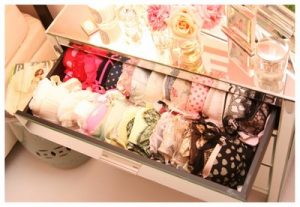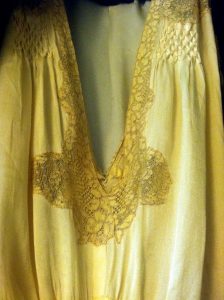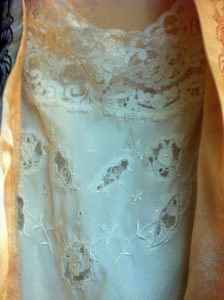
Today is the day you’ve been waiting for! I met Lila Smith three years ago and have wanted her to write a guest post for Hourglassy ever since. In this post, she describes her history with, and love of, lingerie. In tomorrow’s post, she gets to the practical part–how she stores it all.
I was never one for sweatpants, mesh basketball shorts, or similarly unglamorous apparel. When my freshman year Phys-Ed teacher in high school informed us on the first day of class that we would be required to wear pants or shorts with an ELASTIC WAISTBAND, I was horrified. My answer:Â satin pajama pants. Oh, and the matching satin top. I was allowed to wear this as long as I showed up on time and my badminton game didn’t slip. It did not.
There was something defiant about those pajamas. There was an appeal that went beyond the sheen of the fabric under the yellow gymnasium lights. It was a feeling that I was dressing in something that felt distinctly different from the jeans I wore the rest of the day. My pajamas were a transformative costume, in which I could be Jean Harlow, Olga Baclanova, or Myrna Loy. So began a lifelong affair with lingerie.
That transformative effect was, and still is to me, the most powerful draw of the drawer. It can be the purely glamorous appeal of a vintage bias-cut silk nightgown from the ’30s, or the physically transfiguring results of shapewear (oh, you know, Spanx), or any garment in between.
I’ve had the advantage of working in the industry for the past 7 or 8 years, beginning in college upstate when I had a part time job at Private Drawers. The store was a wonderland of decadent piles of neatly folded silky, lacy, strappy, racy bits, stored in antique furniture which we sold as well. If a piece of furniture sold, we’d remove all the lingerie and rearrange it in the next piece to come to the floor. I loved organizing the collection in different ways all the time, depending on how many drawers or how much hanging space a piece would have. It was like a puzzle where the pieces were made of the world’s softest and sexiest things. I vowed that my own drawers and closets would always be full of lingerie as well, and then began to seriously build my collection.

From Private Drawers I purchased my first vintage piece: an ivory silk bias-cut, ankle-length sleeveless nightgown which tied around the back. It has the most lovingly hand-applied lace at the neckline and shoulders. I swear they still don’t make anything quite like the pieces I’ve collected from the 30’s and ’40s. Jane Woolrich and Janet Reger, both British lingerie designers, are the closest I’ve found to the care required to create something truly spectacular. Christine of Vancouver also makes sumptuous silks and lovely laces.
I learned how to fit women for bras while working at Private Drawers, but I really honed this skill when I worked at La Petite Coquette, the East Village lingerie Mecca where form finally met fit. We never used a tape measure, since it didn’t seem to make a difference. Women wear bra cup sizes for all different reasons, depending on where they’re the fullest. I can identify all shapes and sizes of breasts now, and determine exactly what size bra they should be held by, just by looking. It’s a great party trick.
It was also at La Petite Coquette where I really built the base of a very comprehensive collection of bras and bottoms. They usually match, though I now like to mix it up sometimes. I also became very regimented there about folding things perfectly and organizing them in a way that made sense.

The drawers at La Petite Coquette were organized by size–at least one drawer for each size with fashion bras neatly folded into rows. There were separate drawers in the back where the employees would access the selection of basic bras (a term I have never liked). These are also called t-shirt bras, everyday bras, workhorse bras, and similarly uninviting nomenclature. We organized the bras within each size drawer by brand, so we would best be able to grab the bras we were familiar with when a customer came in for whom they would work perfectly. I’d take one look at a woman and bring her a selection of bras that I felt would suit her size, shape, and lifestyle. I’d always try to find bras in the fashion drawer that would work under a majority of garments, in lieu of a traditional t-shirt bra. If the lace is flat enough, I find I can wear fancy bras under almost anything.